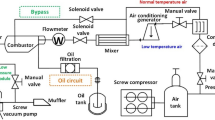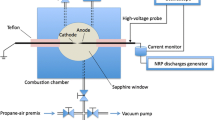Abstract
Plasma-assisted ignition is a promising technology to improve engine performance. Nanosecond repetitive pulsed discharge is widely used in plasma-assisted ignition owing to its chemical activations and thermal and hydrodynamic expansions. However, the influence of ultrafast heating and hydrodynamic effects on the development of the rich-mixture ignition kernel is largely unknown. The present study aims to illustrate these effects using electrical and schlieren measurement. The number and the frequency of discharge pulses are exactly controlled to establish the relationship among the discharge energy, frequency, and rich-mixture ignition-kernel characteristics. The evolution of the ignition kernel in the early stage is mainly dominated by the discharge energy and frequency, i.e., a greater energy and a higher frequency yield a larger ignition kernel. Moreover, the influence of both the energy and frequency on the ignition kernel gradually disappears as the ignition kernel develops. According to the experimental data and theoretical analysis, the calculated laminar burning velocity is 0.319 m/s with a Markstein length of 13.43±0.11 cm when the voltage is 5.9 kV, the frequency is 3 kHz, and the equivalence ratio is 1.3. This result indicates that the rich-mixture flame is stable in the early stage of ignition.
Similar content being viewed by others
References
Starikovskiy A, Aleksandrov N. Plasma-assisted ignition and combustion. Aeronaut Astronaut, 2011, 1: 331–368
Sun W, Ju Y. Non-equilibrium plasma-assisted combustion: A review of recent progress. J Plasma Fusion Res, 2013, 89: 208–219
Starikovskiy A, Aleksandrov N. Plasma-assisted ignition and combustion. Prog Energ Combust, 2013, 39: 61–110
Starikovskii A Y. Plasma-supported combustion. P Combust Inst, 2005, 30: 2405–2417
Starikovskaia S M. Plasma-assisted ignition and combustion. J Phys D Appl Phys, 2006, 39: 265–299
Pancheshnyi S, Lacoste D A, Bourdon A, et al. Ignition of propaneair mixture by a repetitively pulsed nanosecond discharge. IEEE T Plasma Sci, 2006, 34: 2478–87
Cathey C D, Tang T, Shiraishi T, et al. Nanosecond plasma ignition for improved performance of an internal combustion engine. IEEE T Plasma Sci, 2007, 35: 1664–1668
Cathey C D. Spatial and time resolved study of transient plasma induced OH production in quiescent CH-air mixtures. Dissertation of Doctor Degree. California: University of Southern California, 2007
Xu D A. Thermal and hydrodynamic effects of nanosecond discharges in air and application to plasma-assisted combustion. Dissertation of Doctor Degree. Paris: Ecole Centrale Paris, 2014
Xu D A, Lacoste D A, Laux C O. Schlieren imaging of shock-wave formation induced by ultrafast heating of a nanosecond repetitively pulsed discharge in air. IEEE T Plasma Sci, 2014, 42: 2350–2351
Ozasa T, Kozuka K, Fujiakawa T. Schlieren observations of in-cylinder phenomena concerning a direct-injection gasoline engine. In: Proceedings of the 1998 SAE International Fall Fuels and Lubricants Meeting and Exposition, San Francisco: SAE, 1998. 982696
Fukanno Y, Hisaki H, Kida S, et al. In-cylinder combustion in a natural gas fueled spark ignition engine probed by high speed schlieren method and its dependence on engine specifications. In: Proceedings of the 1999 SAE International Spring Fuels and Lubricants Meeting and Exposition, Dearborn: SAE, 1999. 01 1493
Eisazadeh-Far K, Parsinejad F, Metghalchi H, et al. On flame kernel formation and propagation in premixed gases. Combust Flame, 2010, 157: 2211–2221
Zhao Q, Liu S Z, Tong H H. Plasma Technology and Application. Beijing: National Defence Industry Press, 2009. 2
Aleksandrov N L, Kindusheva S V, Kosarev I N, et al. Analysis of energetic efficiency and kinetics of intermediates in the problem of plasma assisted ignition. In: AIAA Aerospace Sciences Meeting Including the New Horizons Forum and Aerospace Exposition 2009–0692, Orlando, Florida, 2009
Rusterholtz D L, Lacoste D A, Stancu G D, et al. Ultrafast heating and oxygen dissociation in atmospheric pressure air by nanosecond repetitively pulsed discharges J Phys D Appl Phys, 2013, 46: 464010
Popov N A. Investigation of the mechanism for rapid heating of nitrogen and air in gas discharges. Plasma Phys Rep, 2001, 27: 886–896
Ko Y, Anderson R, Arpaci V. Spark ignition of propane–air mixtures near the minimum ignition energy: Part I. An experimental study. Combust Flame, 1991, 83: 75–87
Chen Z, Burke M P, Ju Y G. Effects of Lewis number and ignition energy on the determination of laminar flame speed using propagating spherical flames. P Combust Inst, 2009, 32: 1253–1260
Shiraishi T, Urushihara T, Gundersen M. A trial of ignition innovation of gasoline engine by nanosecond pulsed low temperature plasma ignition. J Phys D Appl Phys, 2009, 42: 135208
Bradley D, Gaskell P H, Gu X J. Burning velocities, Markstein lengths, and flame quenching for spherical methane-air flames: A computational study. Combust Flame, 1996, 104: 176–198
Huang Z, Zhang Y, Zeng K, et al. Measurements of laminar burning velocities for natural gas-hydrogen air mixtures. Combust Flame, 2006, 146: 302–311
Metghalchi M, Keck J. Laminar burning velocity of propane-air mixtures at high temperature and pressure. Combust Flame, 1980, 38: 143–154
Vagelopoulos C, Egolfopoulos F, Law C K. Further considerations on the determination of laminar flame speeds with the counter-flow twin-flame technique. In: 25th Symposium (international) on combustion, Pittsburgh, PA: The Combustion Institute, 1994. 1341–1347
Zhao Z, Kazakov A, Li J, et al. The initial temperature and N2 dilution effect on the laminar flame speed of propane/air. Combust Sci Technol, 2004, 176: 1705–1723
Author information
Authors and Affiliations
Corresponding author
Rights and permissions
About this article
Cite this article
Lin, B., Wu, Y., Li, Y. et al. Characteristic of rich-mixture ignition kernel driven by nanosecond repetitive pulsed discharge. Sci. China Technol. Sci. 59, 109–116 (2016). https://doi.org/10.1007/s11431-015-5950-9
Received:
Accepted:
Published:
Issue Date:
DOI: https://doi.org/10.1007/s11431-015-5950-9




